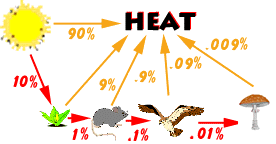Energy flow and energetics of ecosystem


Photosynthesis explains how energy from the sun is captured by green plants and used to make food. Most of this energy is used to carry on the plant's life activities. The rest of the energy is passed on as food to the next level of the food chain.
The figure above shows energy flow in a simple food chain. At each level of the food chain, about 90% of the energy is lost in the form of heat. The total energy passed from one level to the next is only about one-tenth of the energy received from the previous organism. Therefore, as you move up the food chain, there is less energy available. Animals located at the top of the food chain need a lot more food to meet their energy needs.
NOTE!! Each organism in the food chain is only transfering one-tenth of its energy to the next organism.
Trytryitlogo this fun activity with your class to help make this more clear. Think of energy as rootbeer. The teacher will represent the sun and four students will represent the organisms in a food chain: a plant, an insect, a sparrow and a hawk. You will need a liter of rootbeer, graduated cylinders, and an eyedropper.
Reviewing the above diagram, we find that:
* The sun has one liter of rootbeer (energy) to give.
* Of that, the plant gets one-tenth or 100 milliliters.
* The mouse gets 10 milliliters from the plant.
* The hawk gets 1 milliliter from the mouse.
* When the hawk dies and is decomposed by the mushroom, the mushroom gets only one-tenth of a milliliter!
When the rootbeer has been distributed in the correct amount to each participating student, they can drink their share.
The extra rootbeer that the sun does not give to the plant, is likened unto the 90% energy lost to the environment. You as the teacher to simulate this energy loss, pour the remaining rootbeer down the drain and listen to the moans of your students!
After doing the activity, answer these questions.
1.Which organism was most satisfied by the amount of "energy" he or she received? Which organism was least satisfied?
2. What happened to the 900 milliliters from the sun that the plant didn't absorb?
3. How much "energy" was USED by the insect?
4. What consumer in the food chain is going to have to eat the most food to meet their energy needs?
5. Why can't a food chain have an infinite number of links?
You can see that because energy is lost at each step of a food chain, it takes a lot of producers to support a few top consumers. The food pyramid below shows an example of this.

Notice that if there were a 1000 units of energy at the producers level the primary consumers would recieve 100 units of energy, the secondary consumers would recieve 10 units of energy, and the terciary consumer would recieve 1 unit of energy. This pyramid helps to demonstrate the loss of energy from one level of the food chain to the next.
http://www.usoe.k12.ut.us/curr/Science/sciber00/8th/energy/sciber/ecosys.htm
Code: ZO4B1
(a) Energy flow and energetics of ecosystem
posted by jishasooriya at
7:15 PM
0 Comments:
Post a Comment
<< Home